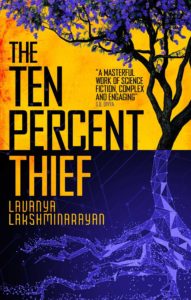In Apex City, known in former centuries as Bangalore, meritocracy and sound scientific management principles have produced a city that has not only survived the environmental catastrophes, it is home to thriving humanity and extraordinary individuals extending what is humanly possible in many fields of endeavor. In the Virtual society inside Apex City, seventy percent work to support the excellence of the top twenty percent, whose personal merit and achievements bring them every possible comfort and all the resources necessary to become ever better versions of themselves, and thus keep improving humanity itself. The Curve is constantly updated, and it cannot err. The bottom ten percent cannot be allowed to drag Virtual society down to their level, so they are given opportunities to become more Productive. If they cannot even manage that they are given support for their transition to Analog lives outside the city. It is humane and objectively correct.
The Ten Percent Thief is a mosaic novel of the dystopia in and outside of Apex City, and by implication the other cities around the world governed on the same principles by Bell Corp. Because of course despite the indoctrination and nearly omnipresent surveillance, there is life outside of Virtual society and unhappiness leading to opposition within. The book is classic “If this goes on…” science fiction extrapolation applied to South Asian parts of a global society, with equally classic underground opposition to the well-meaning utopia that has, unsurprisingly, turned dystopic.
Everyone is striving against unforgiving norms, and they are afraid of sliding down the wrong side of the Curve. People with great power take pleasure in using it on people lower on the Curve, and they also do their best to keep as much for themselves and their immediate circles. And while the Curve is by definition perfect, the people have human foibles that Virtual society refuses to acknowledge. One striver comes from the wrong background; another falls into grief, Productivity dropping like a rock, when their mother dies. Others refuse to play the roles foreseen for them, for example, by being unwilling to carry a child designed to be a genetic step up, but conceived with someone selected by Bell Corp rather than with their spouse.
At times Virtual society comes close to recognizing that its closed system is imperfect: a pianist who has not been trained with the Virtual tools of a metronome implant and guidance for fingerings and dynamics is on the verge of being designated a Virtuoso because she plays with humanity instead of perfection. Many other times, the Virtuals see the Analogs who maintain the system’s systems, but at the same time do not ever see them, as ruling classes have so often been able not to see servants.
The Ten Percent Thief has plenty of virtues. Apex City is chilling, and Lakshminarayan captures how social pressure can work together with technology to enforce norms more thoroughly than either one. She also captures how the Curve offers real opportunities to a certain number of people, thus encouraging many more to go along with the system in hope that it might work for them, too. She gives glimpses of the corruption that has plagued so many utopian experiments — as Bell Corp’s regime surely is — and often turns out to be the grease that keeps the wheels of many dystopias turning. The pace of the stories never flags, and the form Lakshminarayan has chosen enables her to show many different facets of the world she has built.
On the other hand, that same form means that characters often appear in a single episode and are more recognizable to readers as types than as individuals. There’s a trade-off among length, the number of episodes she uses to create her mosaic, and the depth of the individual characters, even though she’s got a good feel for the telling details that form individuals. Even her title character is an appellation rather than a name.
The inevitable rebellion is also unusually coherent. While Virtual society is a snake-pit of people trying to hold their positions on the Curve or to climb up its slope, the Analog rebels are united, the different groups filling their allotted roles. One group is even expected to harbor collaborators and snitches, and the rebel council acts accordingly. I wonder what The Ten Percent Thief would have been like with a rebellion story that was less programmatic, or without one at all. Ursula K. Le Guin called The Dispossessed an ambiguous utopia. What would it have taken for The Ten Percent Thief to be a more ambiguous dystopia? Is that the difference between a very good novel and a great one?

